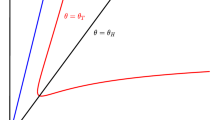Abstract
This paper investigates the predator-prey system:
with
whereα, β, τ; k 1,k 2,k 3 are positive constants.
The main results are as follows
-
(i)
In casek 3−βk 2 τ≥0 system (1) has no limit cycle.
-
(ii)
In casek 3 −βk 2 τ<0, k 1+k3 −βk 2 τ>0, and for 0<α≪1, system (1) at least has two limit cycles.
Similar content being viewed by others
References
Dubois, D. M., P. Z. Closset, Patchiness. In Primary and Secondate Prodaction in the Southem, Bight: A Mathematical Theory, Proceding off the 10th European Sympesimm on Marine Biology, Ostend. Universa Press ED by Presoome and Jaspers. Vol. 2, 1975, 211–229.
Bantin, N. N., On Periodic Solutions of a System of Differential Equations (R),Prikl. Mat. Mak. 18 (1954), 128.
Author information
Authors and Affiliations
Rights and permissions
About this article
Cite this article
Ren, Y., Han, L. The predator-prey model with two limit cycles. Acta Mathematicae Applicatae Sinica 5, 30–32 (1989). https://doi.org/10.1007/BF02006184
Received:
Issue Date:
DOI: https://doi.org/10.1007/BF02006184




